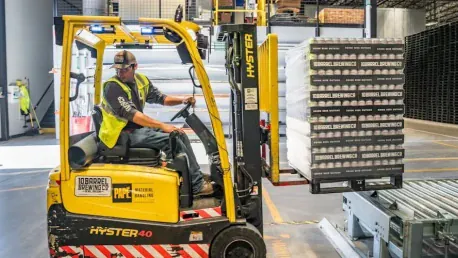In the wake of the COVID-19 pandemic, global supply chains faced unprecedented disruptions, revealing significant vulnerabilities in operations. Hapag-Lloyd, a leading global ocean carrier, recognized the need for enhanced visibility and control over its supplier base. To address these challenges, the company strategically deployed Craft’s technology platform, leveraging big data and artificial intelligence to improve supplier transparency and management.
The Need for Enhanced Supplier Management
Identifying Operational Vulnerabilities
In 2020, the pandemic led to a surge in freight and port congestion, exposing critical weaknesses in Hapag-Lloyd’s operations. The lack of data and efficient information sharing became apparent, prompting the company to seek solutions for better supplier management. Daniel Braune, head of procurement at Hapag-Lloyd, emphasized the importance of timely and reliable supplier performance, particularly in ensuring the punctuality of truckers and other transport providers. The pandemic exacerbated pre-existing issues within their supply chains, highlighting the delicate balance required to maintain global logistics operations smoothly.
Hapag-Lloyd’s response to these vulnerabilities involved a deep dive into their supply chain processes, revealing that fragmented data and inadequate communication channels were major contributing factors to the inefficiencies experienced. By not having a comprehensive view of their suppliers’ operations, Hapag-Lloyd found it challenging to predict and manage disruptions effectively. This realization drove them to search for advanced technological solutions capable of consolidating diverse data sources, analyzing patterns, and providing real-time insights into supplier activities and potential risks.
Partnering with Craft’s Technology Platform
In 2021, Hapag-Lloyd partnered with Craft’s supply chain technology platform to address these vulnerabilities. The goal was to achieve deeper visibility and manage the complexities of their supply chain through a robust supplier intelligence portal. Craft’s platform collects and analyzes data from various sources, providing Hapag-Lloyd with critical insights into their suppliers’ performance and potential risks. Leveraging this technology allowed Hapag-Lloyd to gain a more holistic view of their supply chain, helping them to identify both immediate issues and long-term trends that could impact operations.
Craft’s platform offers a comprehensive suite of tools designed to enhance supplier management, including real-time data aggregation, advanced analytics, and predictive modeling. For Hapag-Lloyd, this partnership meant not only gaining access to cutting-edge technology but also benefiting from Craft’s expertise in supply chain optimization. This collaboration enabled Hapag-Lloyd to shift from a reactive to a proactive approach, allowing them to anticipate and mitigate disruptions before they could significantly affect their operations. The implementation of Craft’s platform marked a significant step towards transforming their supply chain into a more resilient and adaptive system.
Leveraging Big Data and AI for Supplier Insights
Gathering and Analyzing Supplier Data
Hapag-Lloyd utilizes Craft’s technology to collect essential data, monitor news alerts related to their suppliers, and foster internal corporate collaboration. Craft sources supplier data through industry partners, proprietary machine learning, and operational data from companies. This comprehensive intelligence system enables Hapag-Lloyd to stay informed about their suppliers’ status and performance, providing a level of transparency that was previously unattainable. The ability to access and analyze a vast array of data points allows Hapag-Lloyd to make informed decisions that enhance operational efficiency and reduce risks.
The integration of big data and AI into their supplier management strategy has also enabled Hapag-Lloyd to identify patterns and trends that could indicate potential future disruptions. By continuously monitoring and analyzing data, they can detect early warning signs and take preventive actions to mitigate risks. This proactive approach helps them maintain a higher level of service continuity, even in the face of unforeseen challenges. Moreover, the platform’s advanced analytics capabilities allow Hapag-Lloyd to evaluate supplier performance more accurately, ensuring that they can uphold high standards and meet customer expectations consistently.
Navigating Supply Chain Disruptions
Craft’s platform proved invaluable during significant disruptions, such as the strike at East and Gulf Coast ports in the fall of 2022. The strike caused certain ports to shut down operations for three days, presenting substantial challenges to shipping companies. However, with the visibility provided by Craft’s platform, Hapag-Lloyd could mitigate the disruption’s impact. Timely alerts and updates allowed the company to adapt schedules and ensure continuity of customer service. The ability to receive real-time information enabled Hapag-Lloyd to respond quickly and effectively, minimizing the negative effects on their supply chain.
During the strike, Craft’s platform helped Hapag-Lloyd reroute shipments, adjust logistics plans, and communicate with affected stakeholders efficiently. This level of responsiveness not only reduced delays but also reinforced their reputation for reliability among customers. By leveraging the insights provided by the platform, Hapag-Lloyd could maintain a high level of operational resilience and continue to deliver on their commitments despite external disruptions. This experience underscored the critical importance of having robust, data-driven tools to navigate the complexities of global supply chains and ensure service excellence.
Proactive Risk Management
Identifying Financial and Operational Risks
One of the key benefits of Craft’s platform is its ability to identify supplier risks. Ingmar Mester, the director of supplier management and sustainability at Hapag-Lloyd, highlighted the importance of understanding whether a supplier is financially sound to fulfill contracted services. The primary risk they face is a supplier’s failure to provide the agreed-upon services, which could jeopardize deliveries planned for customers. Craft’s platform provides detailed insights into the financial health and operational capabilities of suppliers, enabling Hapag-Lloyd to make informed decisions and mitigate potential risks.
By continuously monitoring financial data and performance metrics, Hapag-Lloyd can detect early signs of financial instability among suppliers. This allows them to take proactive measures, such as seeking alternative suppliers or renegotiating terms to ensure continuity of services. The platform also facilitates the identification of operational risks, such as capacity issues or logistical bottlenecks, which could impact delivery schedules. By having a clear understanding of these risks, Hapag-Lloyd can develop contingency plans and allocate resources more effectively to address potential disruptions.
Monitoring Geopolitical and Regulatory Risks
Beyond financial risks, Hapag-Lloyd keeps a vigilant eye on various geographical and geopolitical risks that could hinder operations. For example, low water levels in the Panama Canal in 2023 affected the amount of cargo passing through, and maritime attacks along the Red Sea caused shipping lines to withdraw or avoid crossing to the Suez Canal. Regulatory risks also play a critical role, especially concerning suppliers who might be placed on sanctions lists. Craft’s platform allows Hapag-Lloyd to spot partners that could pose specific types of risks.
The ability to monitor and assess geopolitical risks is crucial for maintaining operational resilience in a highly interconnected global supply chain. Craft’s platform provides real-time updates on geopolitical events and regulatory changes, enabling Hapag-Lloyd to stay informed and respond swiftly to emerging threats. By understanding the potential impact of these risks, Hapag-Lloyd can make strategic decisions, such as diversifying their supplier base or adjusting shipping routes to minimize exposure. This proactive approach helps them navigate an increasingly complex and unpredictable global landscape, ensuring that they can continue to meet customer demands reliably and efficiently.
Enhancing Operational Resilience
Comprehensive Risk Categories
Craft’s system encompasses over 500 data points across several risk categories, including cybersecurity, finance, geopolitics, regulation, and compliance. These capabilities ensure that Hapag-Lloyd remains informed and proactive about potential disruptions in their supply chain. The platform’s user-friendly nature enables quick onboarding and proficiency for new team members, further enhancing operational resilience. By providing a centralized repository of critical information, Craft’s platform facilitates seamless collaboration and decision-making across the organization.
The comprehensive nature of Craft’s risk categories allows Hapag-Lloyd to address a wide range of potential threats, from cyber attacks to regulatory changes. This holistic approach ensures that they can identify and mitigate risks across all aspects of their operations, enhancing overall resilience. The platform’s advanced analytics and reporting capabilities also enable Hapag-Lloyd to track performance metrics and evaluate the effectiveness of their risk management strategies continuously. This iterative process helps them to refine their approach and improve their resilience over time, ensuring that they can adapt to evolving challenges and maintain a high level of service excellence.
Benefits of Digital Transformation
In the aftermath of the COVID-19 pandemic, global supply chains encountered unprecedented obstacles, exposing significant weak points in their operations. Hapag-Lloyd, a leading global ocean carrier, quickly identified the urgent need for improved visibility and better control over its supplier network. The disruptions highlighted the necessity of modernizing their supplier management to enhance robustness.
To tackle these challenges, Hapag-Lloyd strategically implemented Craft’s advanced technology platform. By harnessing the power of big data and artificial intelligence, the company aimed to boost supplier transparency and refine overall management. This move was essential for addressing the vulnerabilities uncovered during the pandemic’s peak.
The adoption of Craft’s platform allowed Hapag-Lloyd to gain deeper insights into its supplier operations, enabling more informed decision-making and ensuring a more resilient supply chain. This collaboration marked a significant step in mitigating future disruptions and maintaining effective global operations in a post-pandemic world.









